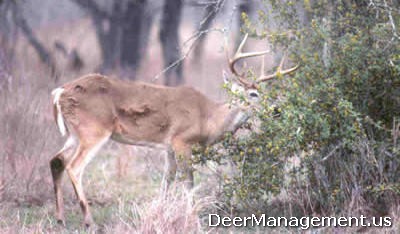Deer hunters know that wetter-than-normal years are better for white-tailed deer than dry ones for reproduction and hunting. Deer management, however, means mitigating for the impacts of abnormal weather. Drought impacts white-tailed deer in many ways. The lack of rain affects the habitat in the areas where whitetail live, which impacts both cover availability and deer nutrition. Food availability and diet, as you can imagine, can be correlated with individual deer body condition. Drought is tough on plants and tough on deer.
Low rainfall means a reduction in both the quality and quantity of deer foods. Both browse and forbs need precipitation for growth. During rainy periods, whitetail deer will consume primarily forbs and new-growth browse because they are loaded with protein. When it’s dry, forbs are very limited and browse plants exhibit little growth, forcing deer to consume older, less nutritious and less palatable leaves and stems.
 Habitat condition affects population recruitment. Wet years mean more fawns are produced. Periods of drought usually result in lower fawn production. Almost all does will still be bred, and will have two embryos the majority of the time, but if a doe’s body condition is poor then she may not raise the fawns or may to raise only one. The doe must take care of herself first, in order live to breed another, hopefully better, year. In addition to food availability, the other way habitat impacts fawn recruitment is because of poor habitat. A lack of rain means herbaceous cover will be limited, especially on properties that have been overgrazed. Reduced ground cover makes fawns more susceptible to predation.
Habitat condition affects population recruitment. Wet years mean more fawns are produced. Periods of drought usually result in lower fawn production. Almost all does will still be bred, and will have two embryos the majority of the time, but if a doe’s body condition is poor then she may not raise the fawns or may to raise only one. The doe must take care of herself first, in order live to breed another, hopefully better, year. In addition to food availability, the other way habitat impacts fawn recruitment is because of poor habitat. A lack of rain means herbaceous cover will be limited, especially on properties that have been overgrazed. Reduced ground cover makes fawns more susceptible to predation.
Drought will also increase deer harvest during the fall. Hungry deer move more. Hungry deer visit spin-feeders more when the habitat is lacking natural forage. This is bad for deer but food for deer hunting. Properties that provide free-choice protein pellets will see big increases in total feed consumption during droughts too. Increased susceptibility to harvest is not necessarily a bad thing because when habitat and individual deer are in poor condition then the right management practice would be to reduce the population size, leaving more food for the remaining animals.
The least important component of drought is reduced antler growth in bucks, although to some hunters this may be the most important impact on a deer herd. Fawns that are born and survive during a drought will have decreased skeletal growth because of possibly reduced milk production by their mothers and decreased forage for them to directly consume. It takes three years to complete skeletal growth in deer, so several years of drought early on in a deer’s life could impact it throughout its life. Supplemental feeding through food plots and high protein, free-choice feeds are the best management practices for ensuring a stable nutritional plane for deer on a property.
It all boils down to decreased food quality and quantity, which is a direct function of deer habitat condition. A whitetail deer herd that is at an appropriate density for a property will fair much better than in areas where there are too many deer. Of course, the habitat found in areas overpopulated with deer will be in poor condition, even when rainfall is normal or above normal. A big part of deer management is making sure the number of deer on a property is in line with what the habitat can reasonably support.
Will antler growth suffer during a drought if you provide free choice protein feed and water? Also, what percent protein is needed? Thank you.
Jimmy,
Antler growth will not “suffer” but will be less during drought. Any difference will likely go unnoticed if feeding protein. Feeding protein tends to add about 10-15% to annual antler growth in bucks in good years. Even though deer consume protein pellets they still eat a lot of native plants. Many native plants are higher in protein (25-35%) than pelleted feeds. So in a bad year, pellets may add 5-10%.
During periods of drought you will want to feed a lower protein pellet. Normal years a pellet with 20% can be feed, but during drought it’s recommended that no more than 16% protein pellet be used. It’s because deer can not live on protein alone. When they consume protein their body tells them to eat plants, too. The problem with drought is that plant availability is low. Hope this helps.